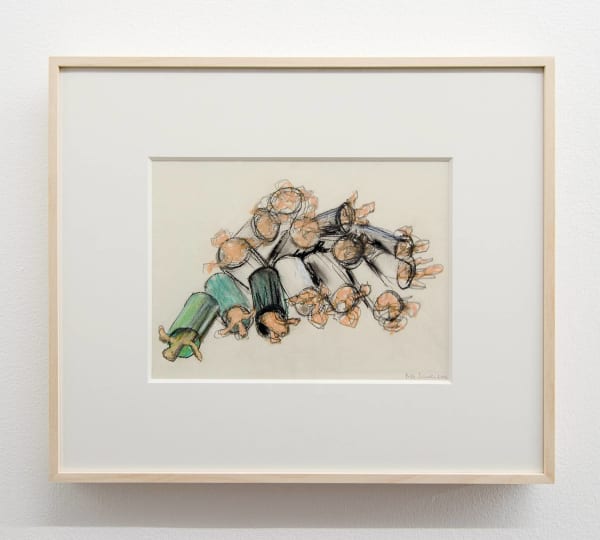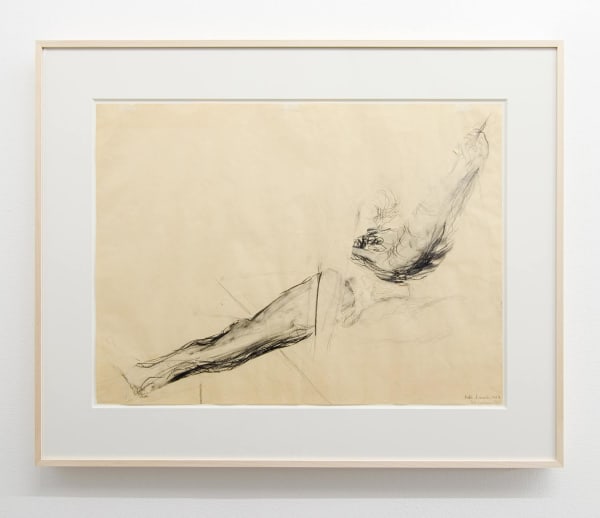By the way. A selection of works 1951 – 2006: Beth Laurin
Beth Laurin's solo exhibition at Belenius consists of a wide and carefully selected group of objects. The works in the exhibition have been made over a range of 55 years. Laurin began her studies at Konstfack in 1953 when she was 18 years old. She studied art for 12 years, first seven years at Konstfack and the five years at the Royal Institute of Art. How does one select works to exhibit from such a long career? The exhibition focuses on drawings, collages and sculptures. Some are abstract, others more figurative.
The oldest works in the exhibition are two water colours on paper, dated 1951. When Laurin was 16 years old, she experimented with various styles. With her works as a point of departure, we are thrown into a personal life story, reflected in the works of art. Laurin tells us about works that has been created during times of love stories, grief and joy. Two of the works made at Konstfack, "Stora lanterninen i gamla Konstfackskolan" ("The Large Lanternin in the Old Konstfack School", 1957) and Två böcker ("Two Books") 1954 were studies made in charcoal, both works reflect a memory of a building, demolished a long time ago.
Laurin also tells us about found objects, something she has work with frequently. Most things she just passes by on the streets, untouched, but some objects become magical to her. To take possession of these objects and transforming them into sculptures is a major theme in her work. The sculpture diptych in the exhibition is beach find from Sandhamn (in the Stockholm archipelago). The objects were found by Laurin during a walk on the beach in the beginning of a love relationship. As all works in the show, they are intimately connected to Laurin's personal experiences.
Dreams are another key theme. The embryos to many of her works can be found in the world of dreams to be completed in the awake time. The sketches for sculptures came about this way. Starting from abstract shapes in dreams, they became realized as final ideas in the awake state. This way, the unconscious and the conscious unite. As in Skiss I (Sketch I), 2006; in a dream, Laurin saw bodies in pipes falling forward, in a messy state. The dream then was transformed into an awake sphere, as a sketches and sculptures. One of Laurin's idols was the professor Ulf Linde and his lectures, events that made her feel high. He could convey this state between dream and reality, like seeing a suit jacket draped over a chair, impossible to distinguish what it is.
Another important theme through her work is the relationship between theoretical ideas in sketches and drawings and the completed sculptures. Figures in drawings who never got a physical shape as sculptures. Two of the works showed consists of four drawings each, in a row. These are sketches from 1965- 1967, made before her studies at the Royal Institute of Art. The drawings are like a journey, where the sculptures jump between the frames to finally get stuck in the last frame. We see a sculpture functioning as a magnet, and how it's drawn to the wall until it starts to dissolve and parts of it get shot out and stuck to the wall. According to Laurin, it tells us about the relationship between people and about attraction. It can be described as love story touching upon the erotic, between sculptures, objects, shapes and humans.
During a flight to Tunisia in 1968, the idea to the work "Vilka alper! Tillägnad Sture"("What Alps! Dedicated to Sture") was born. The work captures the relationship between reality and abstraction in a clear way. Four breasts peak out, like alps through the clouds. The work is based on another love story of Laurin, but a story she doesn't let me write about here. Laurin draws the sketches for her sculptures as self-portraits, and a collage in the show titled "Skulptur på tråd", 1968 ("Sculpture on a thread") uses the sky and spray painted white clouds on baby blue carton as a background to a sculpture portrait. The collage shows Laurin using various materials in a playful way.
Finally, Laurin points out that this is not a retrospective exhibition, but rather shows a selection of her work. The creation of new works is ongoing.
/Valter Sydén











